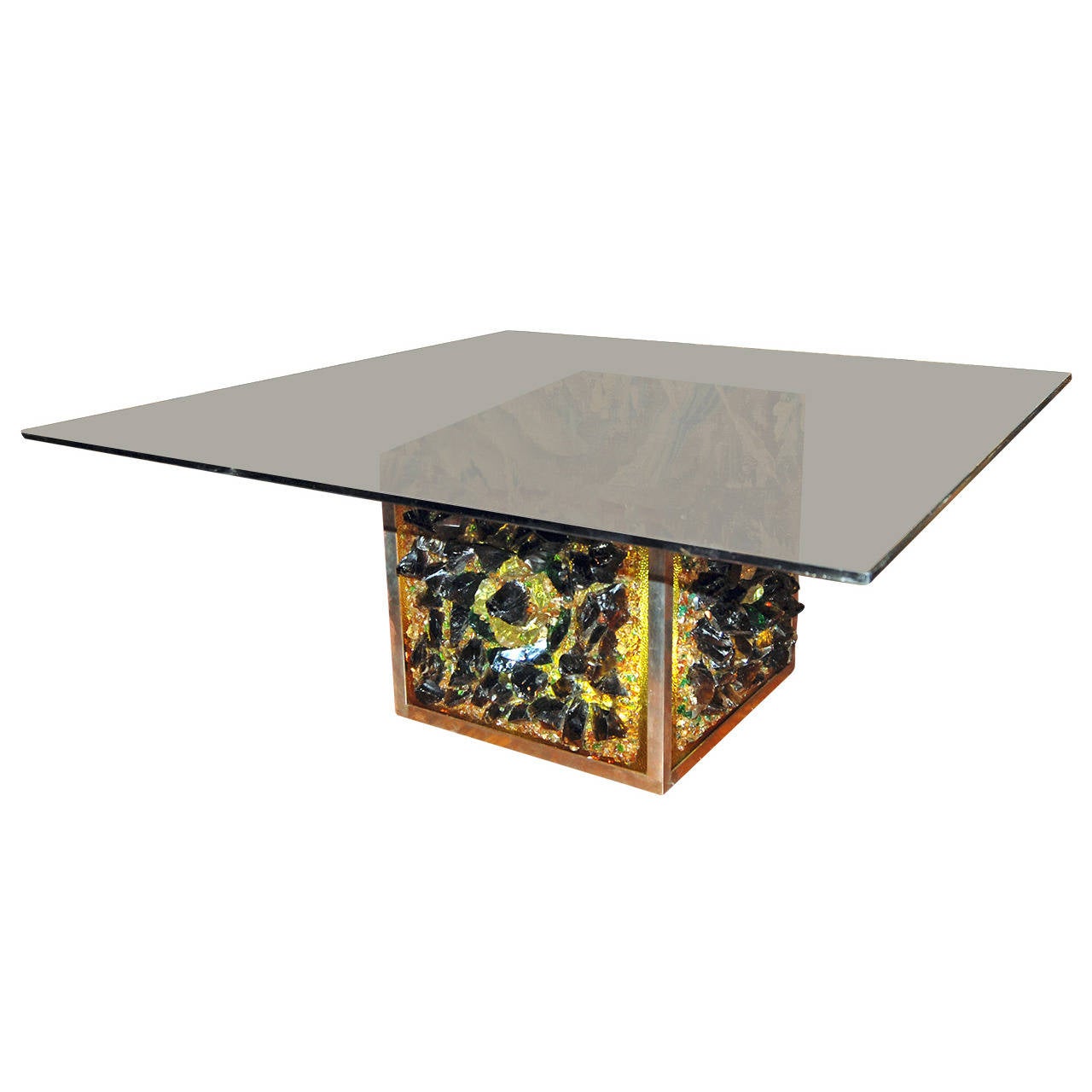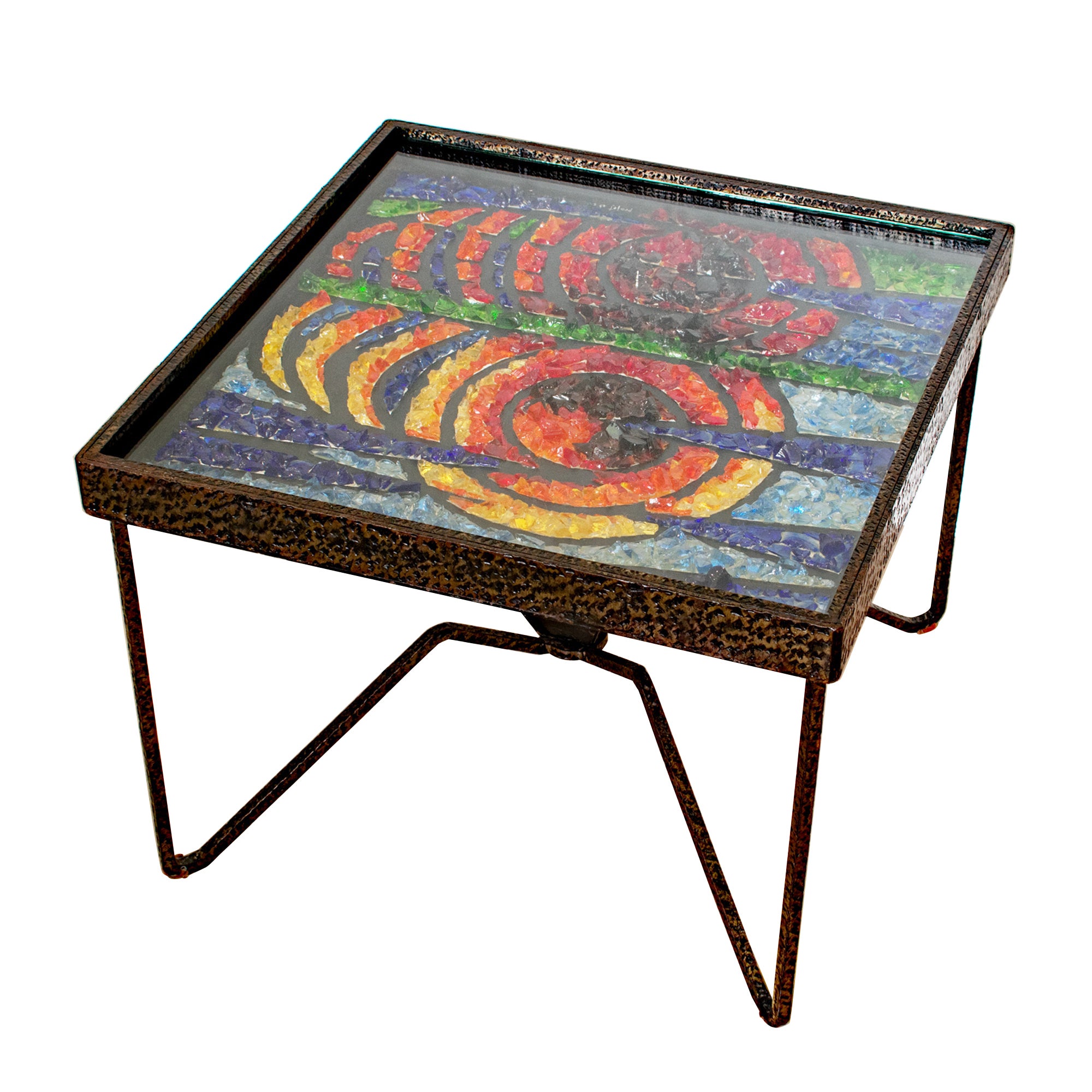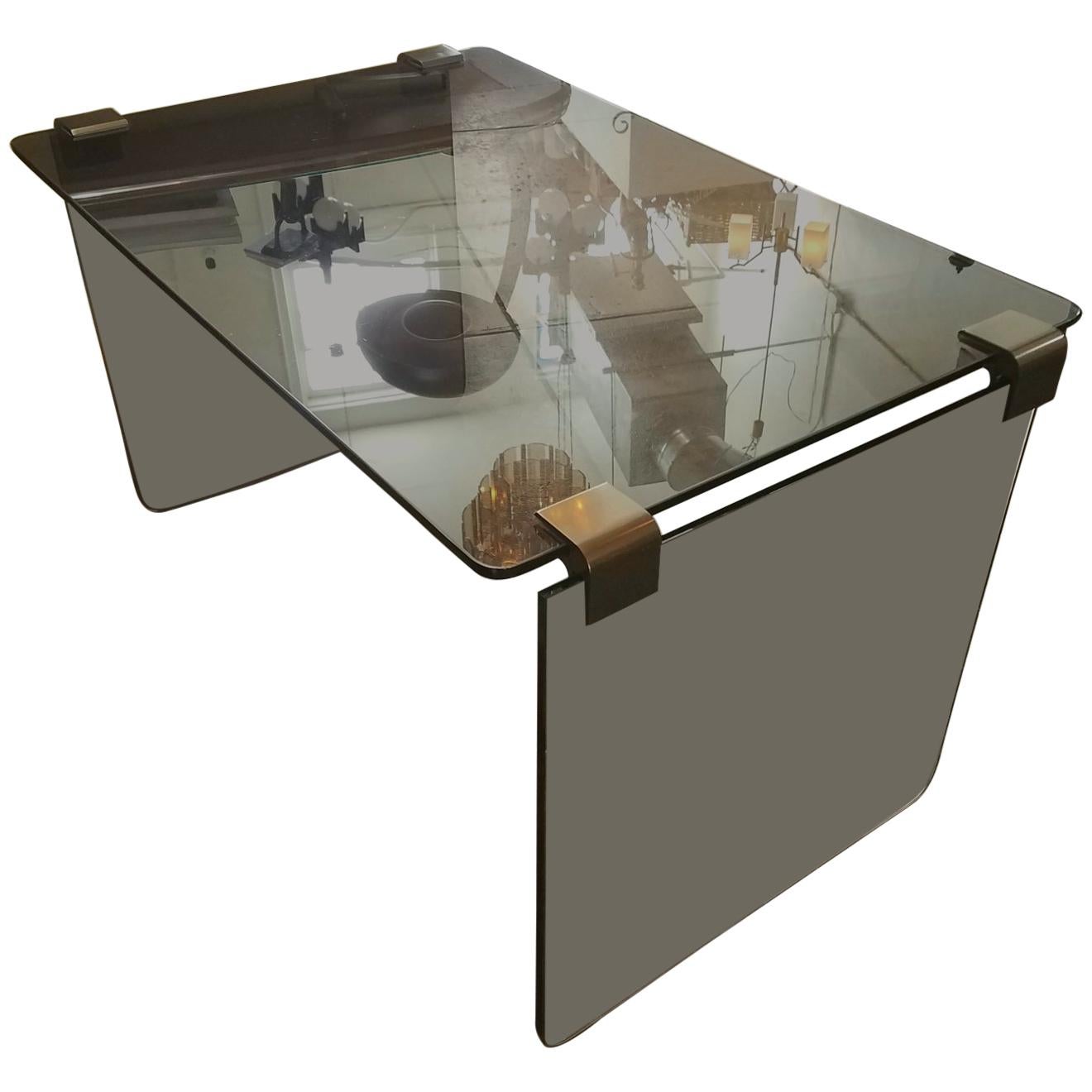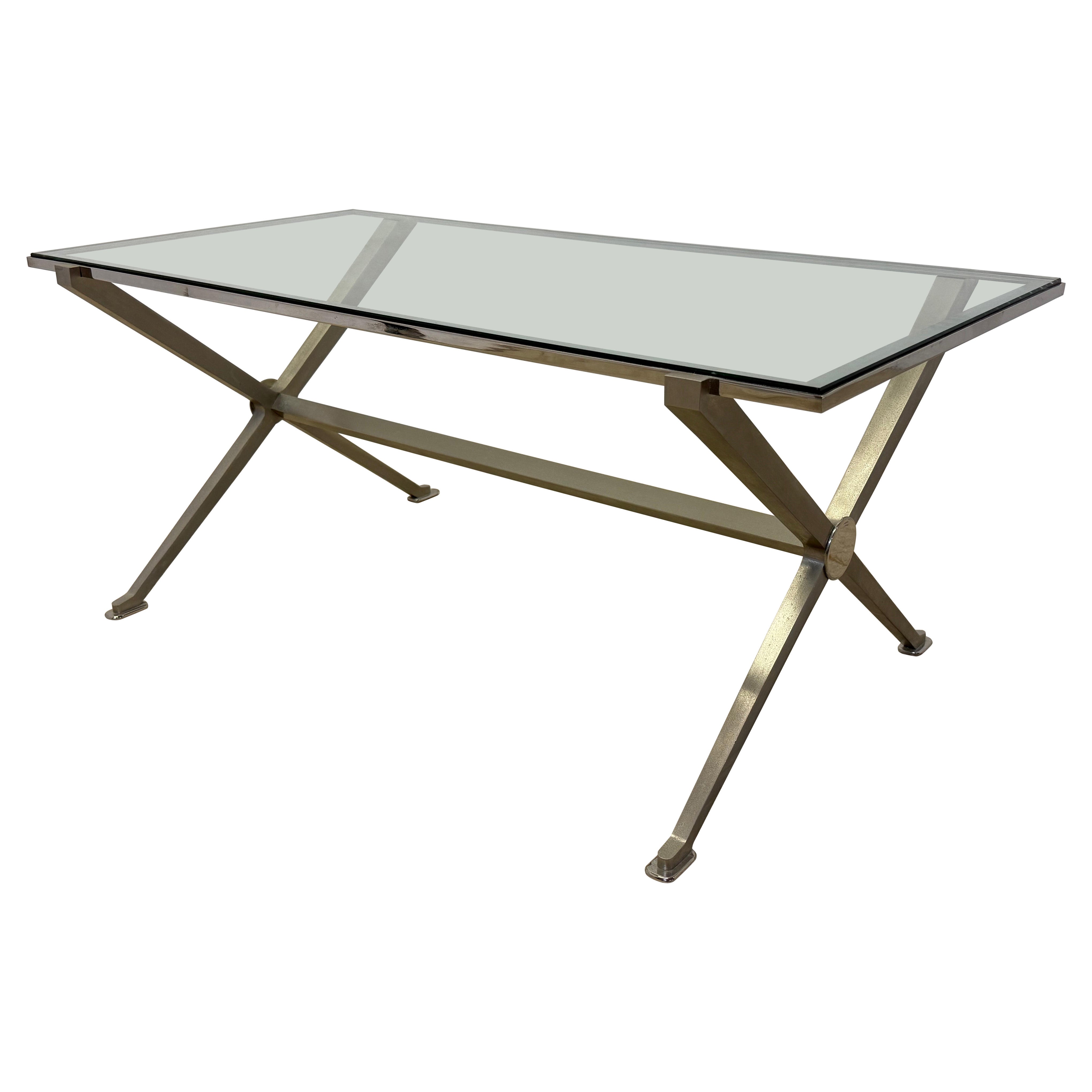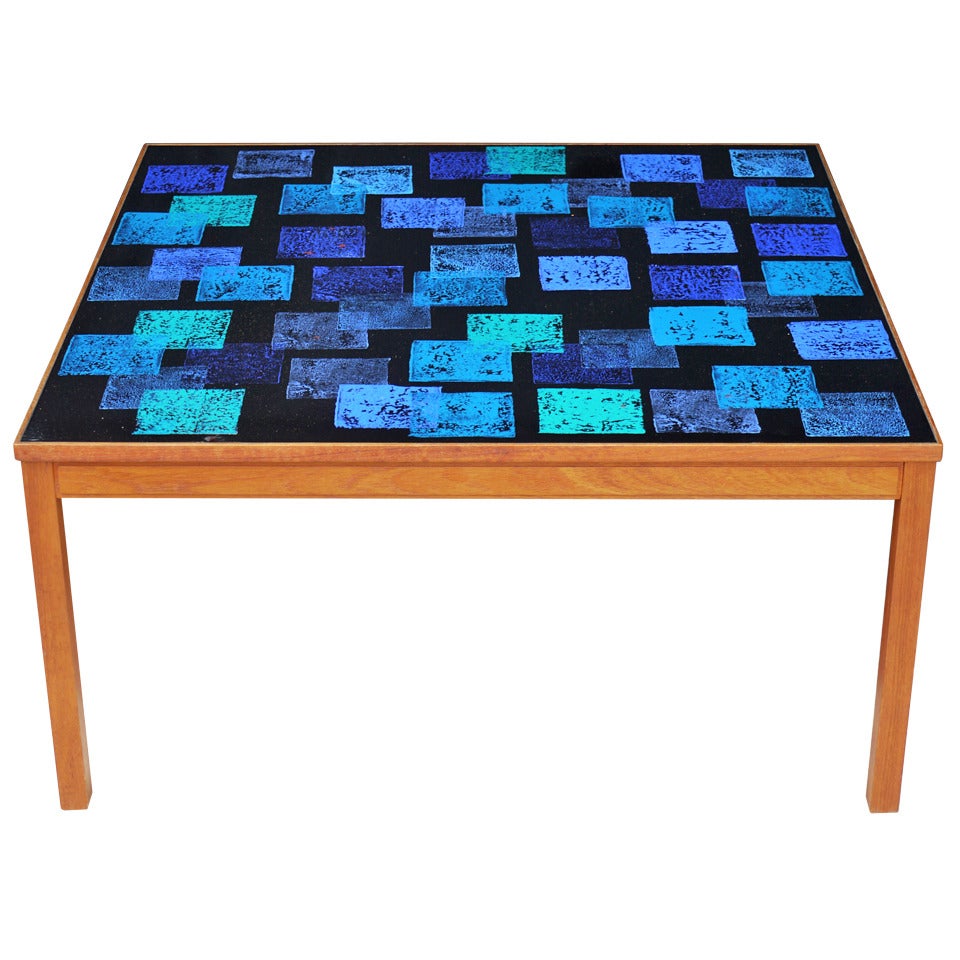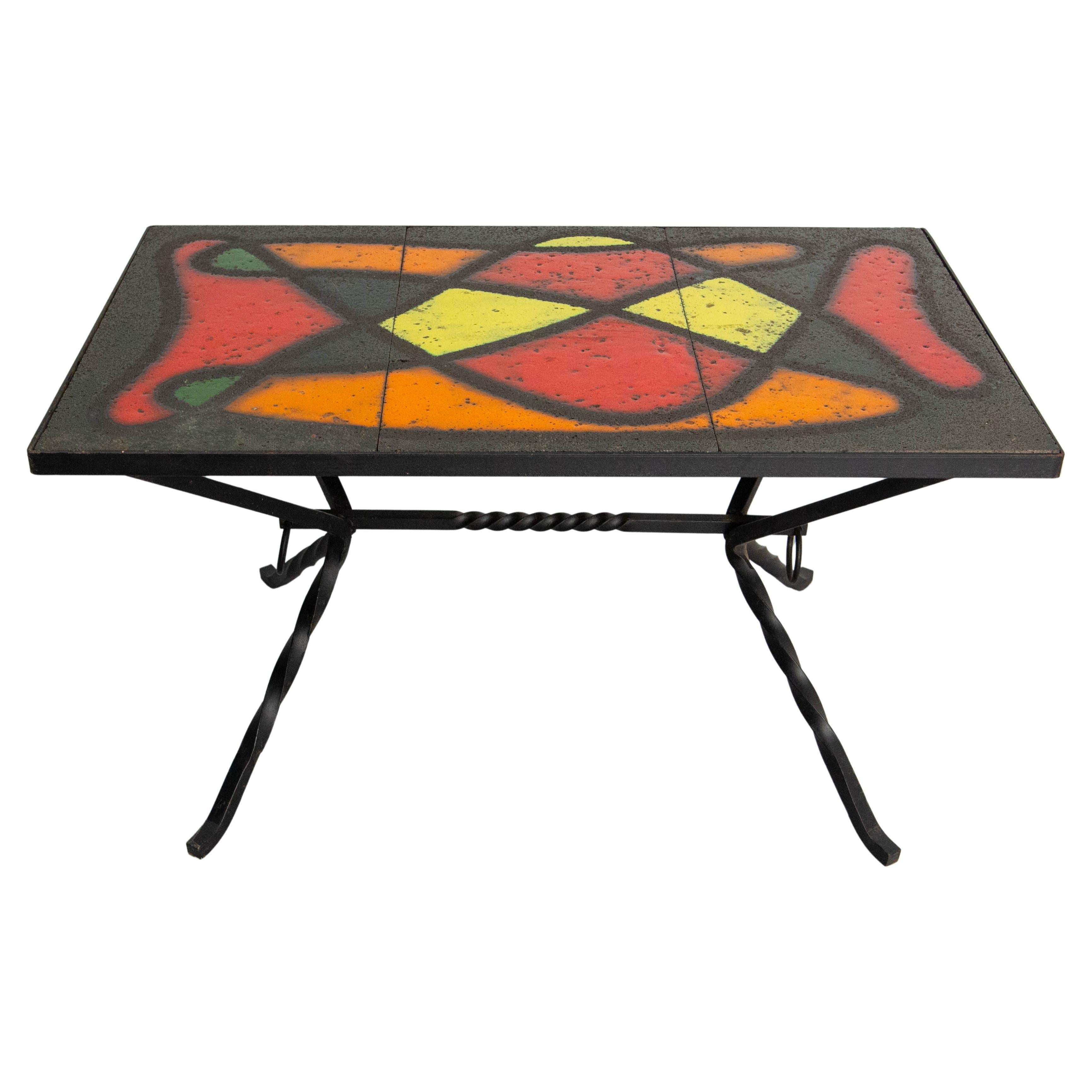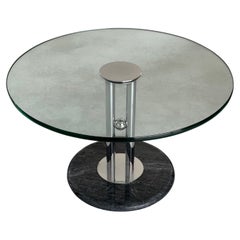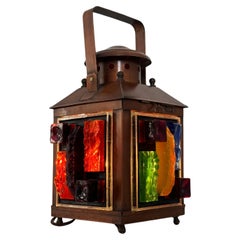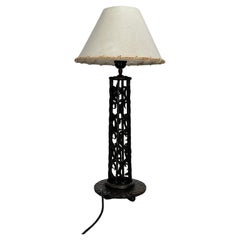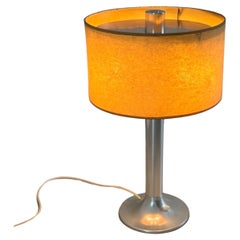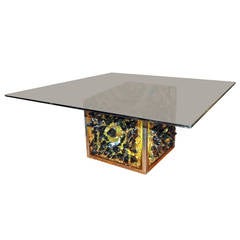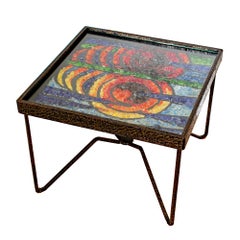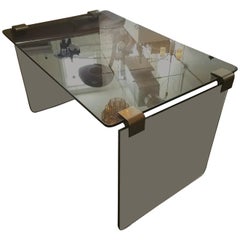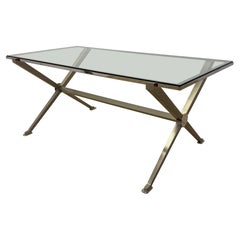Items Similar to André Kulesza Architect. Unique Light Table, Wrought Iron, Glass Crystals 1960s
Video Loading
Want more images or videos?
Request additional images or videos from the seller
1 of 22
André Kulesza Architect. Unique Light Table, Wrought Iron, Glass Crystals 1960s
$19,625.92
£14,578.78
€16,400
CA$27,075.34
A$29,763.24
CHF 15,642.20
MX$361,434.19
NOK 195,132.46
SEK 184,874.29
DKK 124,845.30
About the Item
Exceptional light coffee table by the architect André Kulesza, hammered wrought iron and polychrome stained glass crystals.
The fragments of glass crystals have been carefully selected and combined harmoniously to represent an abstract design.
The glass crystals are fixed on reinforced glass and protected by a window which acts as a table top.
the base is reminiscent of a spider, the 4 feet merge in the center and under the glass crystals to support the light diffuser.
Incredible work of art.
The architect André Kulesza (1913 - 2012) known as the Polish Le Corbusier, carried out this unique production in parallel with the construction of the Polish church in Lens (city in the north of France) of which he was the architect, to commemorate the thousand
years of Christianity in Poland.
This table is like a masterpiece.
Height: 18.11 inch / 46 cm
Width: 24.21 inch / 61.5 cm
Length: 24.21 inch / 61.5 cm
Good condition.
circa 1966
The passionate life of André Kulesza, patriot and architect.
André Olgierd Kulesza passed away in February 2012, at the age of 89. If the name of this Valdericourtian doesn't mean anything to you, his architectural achievements are certainly not unknown, mainly in the north of France.
The town center of Noyelles-lès-Vermelles, buildings in Noeux-les-Mines, the Ephad (accommodation establishment for dependent elderly people) in Sailly-Labourse or Violaines, the Millenium church in Lens and many more Other achievements in France and around the world have marked the career of this Polish immigrant whose destiny was shaken by History.
It must be said that André O. Kulesza already had unusual parents. His mother, from the Polish nobility having lost part of her family massacred by the Bolsheviks in 1917 and taking refuge with her aunt in Poznan, attended Paderewski,
Marie Curie and became a painter; in 1919, speaking excellent French, she worked for the French military mission in Warsaw and a young captain named Charles De Gaulle. Later, she would be a member of the Polish Resistance to the German occupiers. His father, a trained agricultural engineer who became a bank director in Poznan, he crossed all of Europe when the Nazis arrived to join the Polish forces in England, an engagement which prevented him from returning to post-war communist Poland. .
André was 16 years old when the Germans invaded Poland and despite his young age wore the Polish uniform; later arrested in Lublin, he had to be deported to Auschwitz but the Resistance freed him during the transfer and fled to Warsaw,
occupied, tortured and hungry. At the end of the war, he returned to Gdansk with his mother, hiding their membership in the Armia Krajowa, which was being pursued by the communists.
Russians. This is how he entered the faculty of architecture at Gdansk Polytechnic. “It was difficult to escape from the sad communist reality,” he wrote in a memoir in 2010, as he was harassed by the secret police to register with the party.
André Kulesza achieved his first major architectural achievement in a daring way. Still visible today, the church of Wladyslawono on the edge of the Baltic Sea is the result of a project to enlarge the sacristy which the architect will however make... a new church! Built with the help of local fishermen, it was a success for the man who then became the “Polish Le Corbusier”. He therefore participated in various international competitions and notably won that of the construction of a Lutheran church in Copenhagen where, supervised, he was nevertheless able to reconnect with his father. In a moment of political thaw and family reunions authorized, he finally obtains his passport. Recommended by the Primate of Poland, Cardinal Wyszynski, he arrived in France where the Oblate fathers suggested that he build a Polish church in Lens, to commemorate Poland's thousand years of Christianity. There, all of Kulesza's art will be expressed, clearly visible today: stained glass windows made of glass blocks incorporated in concrete representing Polish landscapes. To follow the work, he moved to the Saint-Casimir institute in Vaudricourt, a village that he would never leave since he renovated the church there and built his “house” at the Château-Bois residence. Polish Patria”. There he also opened his office which would experience good times, ensuring a number of achievements: sports halls, town halls, cultural centers... Engaged in actions to support the Solidarnosc union in the 1980s, he met Lech Walesa. His wife
Thérèse, herself of Polish origin and born in Marles-les-Mines, assisted him for many years in his work. Passionate about new metal frames, inventor of a dozen international construction patents, collaborator of MIT in Boston, he imposed a style all his own, all in strong triangles and luminous stained glass windows, forever visible.
- Dimensions:Height: 18.12 in (46 cm)Width: 24.22 in (61.5 cm)Depth: 24.22 in (61.5 cm)
- Style:Arts and Crafts (Of the Period)
- Materials and Techniques:
- Place of Origin:
- Period:
- Date of Manufacture:1960
- Condition:Wear consistent with age and use.
- Seller Location:leucate, FR
- Reference Number:1stDibs: LU7285236689092
About the Seller
5.0
Gold Seller
Premium sellers maintaining a 4.3+ rating and 24-hour response times
Established in 2009
1stDibs seller since 2022
24 sales on 1stDibs
Typical response time: 1 hour
- ShippingRetrieving quote...Shipping from: leucate, France
- Return Policy
Authenticity Guarantee
In the unlikely event there’s an issue with an item’s authenticity, contact us within 1 year for a full refund. DetailsMoney-Back Guarantee
If your item is not as described, is damaged in transit, or does not arrive, contact us within 7 days for a full refund. Details24-Hour Cancellation
You have a 24-hour grace period in which to reconsider your purchase, with no questions asked.Vetted Professional Sellers
Our world-class sellers must adhere to strict standards for service and quality, maintaining the integrity of our listings.Price-Match Guarantee
If you find that a seller listed the same item for a lower price elsewhere, we’ll match it.Trusted Global Delivery
Our best-in-class carrier network provides specialized shipping options worldwide, including custom delivery.More From This Seller
View AllPost-Modern marble & glass coffee table, Italian design, circa 1980s
Located in leucate, FR
Post-Modern designer coffee table.
Marble base, chrome structure composed of two parallel cylinders and a sphere. Circular safety glass top (thickness 2.5 cm, diameter 65 cm).
The ta...
Category
Vintage 1980s Italian Post-Modern Coffee and Cocktail Tables
Materials
Marble, Metal, Chrome
Jacques Avoinet & Jean Simon LABRET style of, French brutalist design lamp 1970s
By Jacques Avoinet
Located in leucate, FR
Design lantern lamp.
Table or ceiling lamp.
Copper and raw and cut glass crystals.
4 sides with thick fragments of backlit glass crystals.
Copper structure with a handle, the whol...
Category
Vintage 1970s French Brutalist Table Lamps
Materials
Copper
French Art Deco Wrought-iron table lamp, 1930s
By Edgar Brandt
Located in leucate, FR
French Art Deco Wrought-iron table lamp.
Beautiful handmade ironwork, very elaborate.
Height excluding lampshade 36 cm / 14,17 inch
Circular base with a diameter of 16 cm / 6,3 in...
Category
Vintage 1930s French Art Deco Table Lamps
Materials
Wrought Iron
Arlus Diffusion, design table lamp, France circa 1970's
By Arlus
Located in leucate, FR
Beautiful desk lamp with a futuristic and classic design.
Cylindrical flared brushed aluminum base, linen lampshade.
Edition ARLUS DIFFUSION.
The lamp is in good condition, some tr...
Category
Vintage 1970s French Space Age Table Lamps
Materials
Aluminum
Authentic 1950s French Folk Art Coffee Table in Solid Oak and Terracotta
Located in leucate, FR
This unique coffee table, a genuine piece of French folk art from the 1950s. Crafted from solid oak, this sturdy and timeless piece highlights the beauty of aged wood, enhanced by wr...
Category
Vintage 1950s French Folk Art Coffee and Cocktail Tables
Materials
Wrought Iron
Magnificent Artistic Ceramic Table Lamp - Unique Piece, Signed AS, France 1970s
Located in leucate, FR
This striking ceramic table lamp, created in France in the late 1970s and signed AS (artist to be identified), stands out as a unique piece of sculptural design. Its organic silhouet...
Category
Vintage 1970s Organic Modern Table Lamps
Materials
Ceramic
You May Also Like
Mid-Century Dutch Illuminated Art Glass Coffee Table
By RAAK
Located in New Orleans, LA
1970s art glass coffee table by RAAK Amsterdam and Willem van Oyen.
Category
Vintage 1970s Dutch Coffee and Cocktail Tables
Modernist Wrought Iron and Glass Mosaic Coffee Side Table, circa 1960
By Paris Studio
Located in Atlanta, GA
Make a striking statement with this rare and exquisite French coffee or side table, a true masterpiece of mid-century artistry, crafted circa 1960. Designed to captivate, this cockta...
Category
Vintage 1960s French Mid-Century Modern Center Tables
Materials
Metal, Wrought Iron
Italian Fume Glass Table by Pace Collection.
By Pace Collection
Located in Los Angeles, CA
Italian 1960s smoke glass table by Pace Collection. Table can be reassemble when bronze glass holder unscrewed.
Shipping to US continental in home delivery $300
Category
Vintage 1960s Italian Mid-Century Modern Coffee and Cocktail Tables
Materials
Smoked Glass
$1,200 Sale Price
36% Off
French Art Deco Revival Glass and Steel Coffee or Cocktail Table, 1970s - 1 of 2
By Maison Jansen
Located in Miami, FL
Inset glass top coffee or cocktail table with brushed steel frame and chrome accents circa 1970s. This French Art Deco inspired table most closely resembles designs by Maison Jansen...
Category
Late 20th Century Unknown Art Deco Coffee and Cocktail Tables
Materials
Steel, Chrome
Enameled Cocktail Table by P. Torneman for NK
By Algot P. Torneman, Nordiska Kompaniet
Located in Kilmarnock, VA
A striking and exceptionally rare enamel on copper coffee table designed by P. Törneman (Algot Törneman) for Nordiska Kompaniet (NK), Sweden’s premier design house and department sto...
Category
Vintage 1960s Swedish Scandinavian Modern Coffee and Cocktail Tables
Materials
Copper, Enamel
French Coffee Table Wrought Iron & Glazed Ceramics, circa 1960
Located in Labrit, Landes
Coffee table with enamelled lava tiles. Parts of the tiles are glazed which creates an interesting contrast creating an interesting contrast of materials and colors.
Typical style of...
Category
Vintage 1960s French Mid-Century Modern Coffee and Cocktail Tables
Materials
Wrought Iron, Enamel
More Ways To Browse
Old Man Of The Sea
Used Concrete Block
Old Church Stained Glass Windows
Tenreiro Coffee Table
Tibet Table
Triangle Table Base
Tribal Bed
Turquoise Tile
Unique Base Coffee Table
Upholstered Cocktail Table
Vintage Wood Lazy Susan
Vortex Table
Walnut Pie Crust Table
White Onyx Coffee Table
White Wash Coffee Tables
Widdicomb Round Table
1980s Coffee Table American
46 Brass And Glass Mid Century Coffee Table
